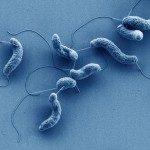Lien vers Pubmed [PMID] – 25492931
Lien DOI – 10.1073/pnas.1420702111
Proc Natl Acad Sci U S A 2015 Jan; 112(1): 178-83
Bacteria can rapidly evolve resistance to antibiotics via the SOS response, a state of high-activity DNA repair and mutagenesis. We explore here the first steps of this evolution in the bacterium Escherichia coli. Induction of the SOS response by the genotoxic antibiotic ciprofloxacin changes the E. coli rod shape into multichromosome-containing filaments. We show that at subminimal inhibitory concentrations of ciprofloxacin the bacterial filament divides asymmetrically repeatedly at the tip. Chromosome-containing buds are made that, if resistant, propagate nonfilamenting progeny with enhanced resistance to ciprofloxacin as the parent filament dies. We propose that the multinucleated filament creates an environmental niche where evolution can proceed via generation of improved mutant chromosomes due to the mutagenic SOS response and possible recombination of the new alleles between chromosomes. Our data provide a better understanding of the processes underlying the origin of resistance at the single-cell level and suggest an analogous role to the eukaryotic aneuploidy condition in cancer.

